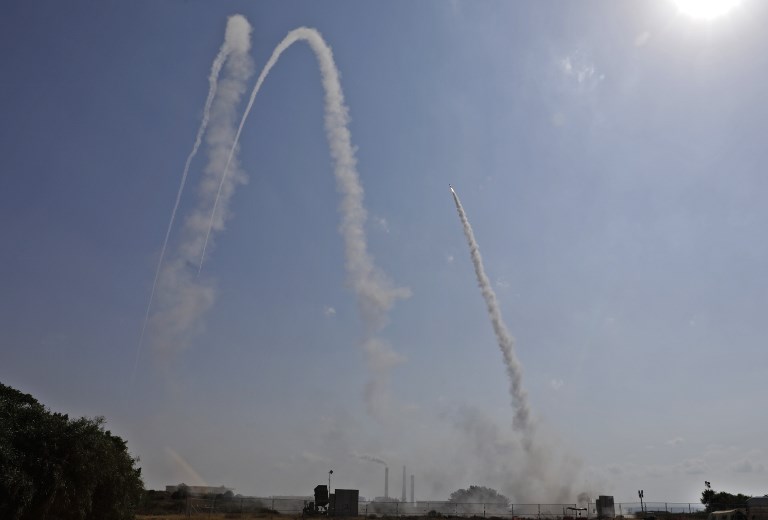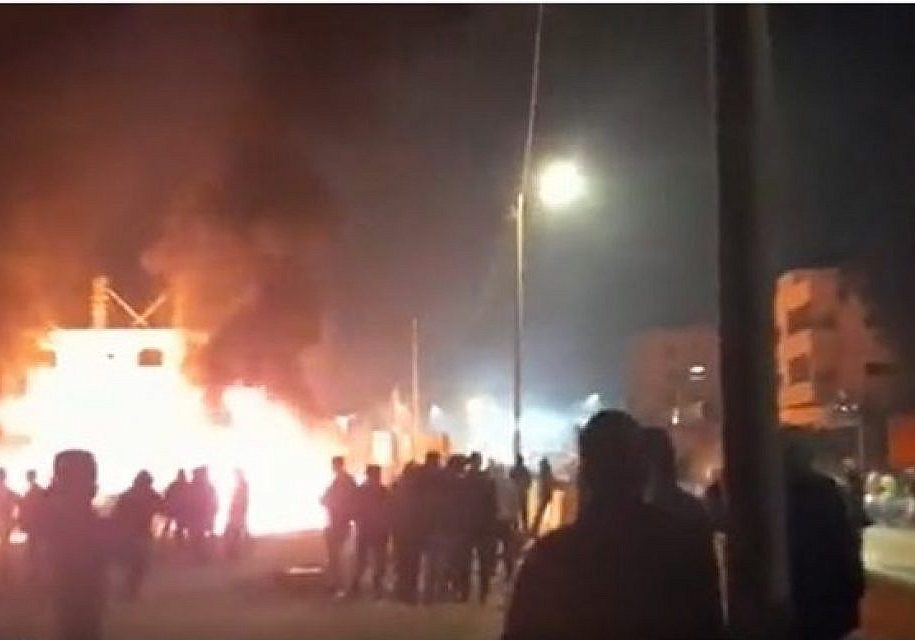FRESH AIR
Is Iran behind the latest attacks on Israel from Gaza?
May 30, 2018 | Tzvi Fleischer

Palestinian Islamic Jihad (IJ) is clearly the main culprit behind the fierce mortar and rocket attacks on Israel that began Tuesday, and saw more than 130 rockets and mortars fired into Israel by Wednesday morning.
It was the heaviest bombardment that Israel has suffered since the end of the 2014 Gaza war. Three soldiers were wounded in the barrage. Meanwhile, one rocket exploded in the yard of a kindergarten, damaging walls and scattering debris and shrapnel around the playground – but fortunately this was about an hour before it was scheduled to open for the day. Another struck an empty house, while fragments of a rocket that had apparently been intercepted by Israel’s Iron Dome defence system damaged a sports facility in the town of Netivot.
In response Israel struck numerous Hamas and PIJ targets with airstrikes in two waves on Tuesday – striking 40 targets in the first wave and an additional 25 in the second.

The Iranian-funded and directed PIJ initiated the firing of the mortars and rockets towards towns along Israel’s southern border. It was later joined by other terror groups from Gaza including Hamas’ Ezzedeen Al-Qassem brigades and the Popular Resistance Committees. This was allegedly in response to the killing of three PIJ militants by Israel when IDF tanks fired on a PIJ observation post near Khan Younis on Sunday.
According to the PIJ’s statements, their actions are meant to settle a ‘blood for blood’ equation, to avenge the death of its people (10 IJ operatives were killed by Israel over the last few weeks). Yet, the latest attack is unusual in its scale and is not in line with past reactions.
How do we explain this full-scale effort by the PIJ? Why it they opt to fire dozens of mortars and rockets in the largest attack on Israel since operation “Protective Edge” in 2014? Why did Hamas and other terrorist organisation jump on the bandwagn and join in – with Hamas joining with PIJ in issuing a joint statement declaring the attacks were “a response to the Zionist aggression and the crimes against our people and the members of the resistance.”
Finally, why is PIJ claiming that an Egyptian-mediated ceasefire is now in place – while Israel is saying there is no such agreement?
Several intertwined factors explain the latest developments.
The first is related to the internal Palestinian political arena. Inside the PIJ there are divisions over how much the organisation should take its orders from Iran. Ziyad al-Nakhalah, the leader of PIJ, is directly tied to Qassem Soleimani, the commander of the Iranian Revolutionary Guards’ Quds Force. But others within PIJ want to align with Turkey or the Muslim Brotherhood, opposing Shi’ite influence over their Sunni organisation. It may be that the attack on Israel was initiated by Iran’s supporters inside PIJ and was meant to prove to Teheran that they still dictate the organisation’s policy.
It may also be part of the turf war and competition over Teheran’s backing between the Iran funded PIJ and Hamas, which is in a dire financial situation and in need of every dollar to maintain its power over the strip. Until recently, Hamas was committed to prevent almost all rocket and mortar attacks against Israel in an attempt to keep the situation in Gaza under its control. However, the Iranians precondition for supplying money (US$70 million a year according to some reports) is the execution of terrorism against Israel.
The relationship between Hamas and Iran soured after the former refused to align with Bashar al-Assad in the Syrian civil war in 2011. Islamic Jihad, on the other hand, sided with the Syrian regime and has participated in battles in Syria alongside Hezbollah. Hence, a formula was created in which Islamic Jihad does not directly challenge Hamas’ control in Gaza in exchange for relative freedom of action.
Today, however, Hamas and Iran have restored good relations, with Hamas’ leader in Gaza Yahya Sinwar recently thanking Iran for providing “a lot of money, equipment, and expertise” and saying relations are now “strong and warm.”
Meanwhile, in a series of diplomatic moves and targeted bombings, Jerusalem has recently been able to dramatically limit Iran’s presence and influence in Syria. Most notably the May 10 strikes, in response to an Iranian rocket attack, reportedly struck 50 Iranian targets in Syria and appear to have severely damaged Iran’s military infrastructure there, but also in ongoing attacks on Iranian bases and positions in Syria, such as the one on the Daba’a military airport last Thursday.
Having failed to successfully attack Israel from Syria (an explosive drone was shut down by the IDF in February; the rocket attack in May was completely unsuccessful), Iran was likely looking for other ways to gain some revenge and save face.
The Iranian response was intended to be both a warning message to Israel that it will respond for when it sustains damages, yet not so harshlyas to lead to an all-out escalation. A direct and violent confrontation with Israel is not in Teheran’s interest right now, as it tries to salvage whatever benefits it can from the European nations still claiming to stick to the JCPOA nuclear deal which US President Donald Trump pulled the US out of earlier this month.
PIJ’s attack, most likely coordinated with Teheran, was thus probably a limited sting directed at Israel. It entails a message Iran can hit Israel on various channels, including through proxies like PIJ, and might drag Israel into a new and costly (and most likely futile) round of violence surrounding Gaza.
Israel acted immediately and fiercely to this implied message, making clear that a red line was crossed, hitting back strongly to attempt to deter both further escalation and any future efforts at launching such waves of rocket attacks.
Israeli public warnings were also strong, with voices in the Israeli government even talking about reconquering the Gaza Strip – a direct threat to Hamas’ rule.
In fact, PIJ’s latest attack left Hamas in an uncomfortable position. On the one hand, it did not want to upset Teheran, nor to be perceived as objecting to attacks on Israel, especially after its ‘March of Return’ campaign gained nothing for Gazans. The organisation cannot afford to be seen to be failing to take part in revenge for those killed in the “March of Return” campaign while PIJ does so.
Yet Hamas also does not want to provoke Israel too much, fearing this might lead to it being toppled or at least another major Gaza conflict which would only make its already difficult political and economic situation worse.
So as Israeli analyst Assaf Gabor wrote in the Hebrew language daily Makor Rishon:
“The firing of mortar shells and rockets do not indicate the desire of the Islamic Jihad or Hamas to launch a renewed round of fighting with Israel, but may nevertheless serve to prove to their sponsors in Teheran that their financial investment in terror, which the Gazans call an uprising, is earning a return.”
The Egyptians – who want calm to deal with their ISIS problem in Sinai, among other reasons – have demanded PIJ and Hamas stop. The result of that pressure campaign was PIJ spokespersons emphasising that they don’t want escalation and claiming a ceasefire was already in place, even though Israel had not yet agreed. Israel was not prepared to agree until it was sure deterrence was fully restored, and it was clear that the status quo that has existed since 2014 – whereby Hamas is held responsible for completely preventing rocket attacks on Israel by any organisation in Gaza – was re-instated.
In conclusion, while the PIJ may have carried out the latest aggression against Israel, it was likely devised by Iran. As in Syria, the path to preventing further deterioration of the volatile situation around Gaza requires containing Teheran.
Tags: Hamas
RELATED ARTICLES

‘Time’s up for talk’: Joel Burnie discusses Antisemitism Envoy’s report on Sky News

‘Optimism’ for Hamas to ‘exile’ their power and create a permanent ceasefire with Israel: Joel Burnie on Sky News

Australian government’s response to Iran-Israel conflict ‘disappointing’: Paul Rubenstein on Sky News




















